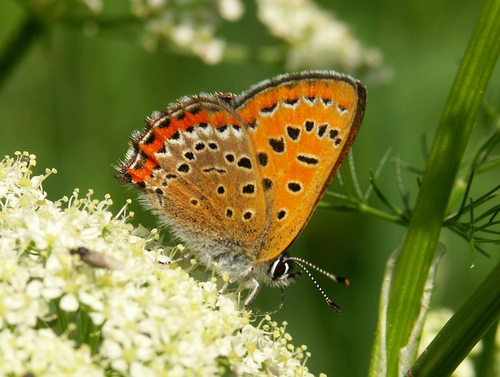
UNEP-WCMC, Dutch Butterfly Conservation, and EU BON recently convened a workshop of 14 global experts from the field of butterfly monitoring, specifically the tropics and subtropics. The workshop has catalysed the process for the development of global butterfly monitoring guidelines and the creation of a new specialist butterfly monitoring group.
Hosted by GEO BON (Group on Earth Biodiversity Observation Network) at the offices of the German Centre for Integrative Biodiversity Research (iDiv) in Leipzig, Germany, the meeting took place on 8th and 9th December 2014. The global experts attending the meeting shared their significant experience and knowledge from the tropics, sub-tropics and deserts; including countries such as Papua New Guinea, Belize, Brazil, Colombia, USA, South Africa, Malaysia, and Liberia.

Blue Copper (Lycaena helle); Credit: Chris van Swaay
Butterfly populations have been monitored in Europe for over 35 years. This monitoring has used standardized protocols, produced long-term datasets, and has resulted in indicators tracking the changes in butterfly populations. These data are proving to be very valuable for informing decision-makers on biodiversity changes and are used at local, national and regional levels to inform conservation management decisions and policies. As a result of the success of schemes in Europe, butterfly monitoring is growing and is now being implemented in countries outside of Europe including North America and Israel using similar protocols.
However, the protocols for butterfly monitoring in temperate regions are not applicable in regions with high numbers of butterfly species such as the tropics. In these biomes methodologies such as fruit-bait traps, counts of puddling butterflies, and timed counts have been used. The aim of this meeting, therefore, was to agree a standard set of methodologies that could be applied globally and from which data could be aggregated through an Essential Biodiversity Variable into a Global Butterfly Indicator.
The main agenda items and points of discussion were an overview of current butterfly monitoring, structured by continent and habitat, with emphasis on the different protocols; steps to process count data into indicators and trends; essential variables required to measure changes in butterfly populations; compatibility of different protocols and the logistics of creating a global indicator; whether the entire species diversity should be measured or just a portion; and agreement on a standard set monitoring protocols.
This workshop has catalysed the development of a number of products, including: global butterfly monitoring guidelines; the development of a Global Butterfly Indicator; and a suite of scientific journal articles on butterfly monitoring in different regions of the world. The development of an Essential Biodiversity Variable (EBV) ‘butterfly population abundance’ that will facilitate the harmonisation of butterfly monitoring data from different habitat types and regions is also being developed. A new butterfly monitoring specialist group has also been established to provide support for practitioners working in the field of butterfly monitoring and to continue momentum from this workshop.
The standardization of monitoring protocols that can be implemented in any country is crucial for the robust estimation of butterfly populations globally to assess progress towards the 2020 targets of the Convention on Biological Diversity (CBD). These guidelines can also provide the foundation for developing scenarios for the future of butterfly populations under different policy and management options. The outcomes of this meeting provide a clear path to increased harmonization among the efforts of global butterfly experts in different regions and towards the establishment of a Global Butterfly Indicator.
We would like to thank GEO BON and EU BON for funding this meeting.

Participants of the butterfly monitoring experts meeting at iDiv, Leipzig, Germany, December 2014




 RSS news
RSS news Print this article
Print this article
